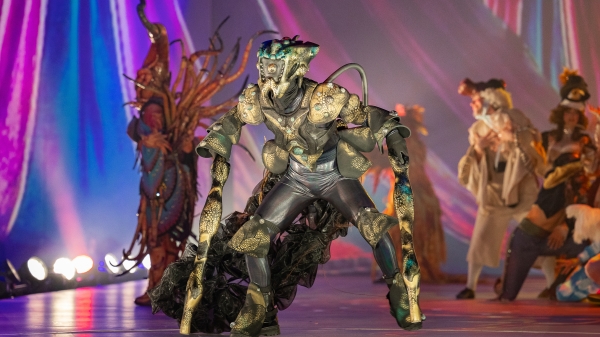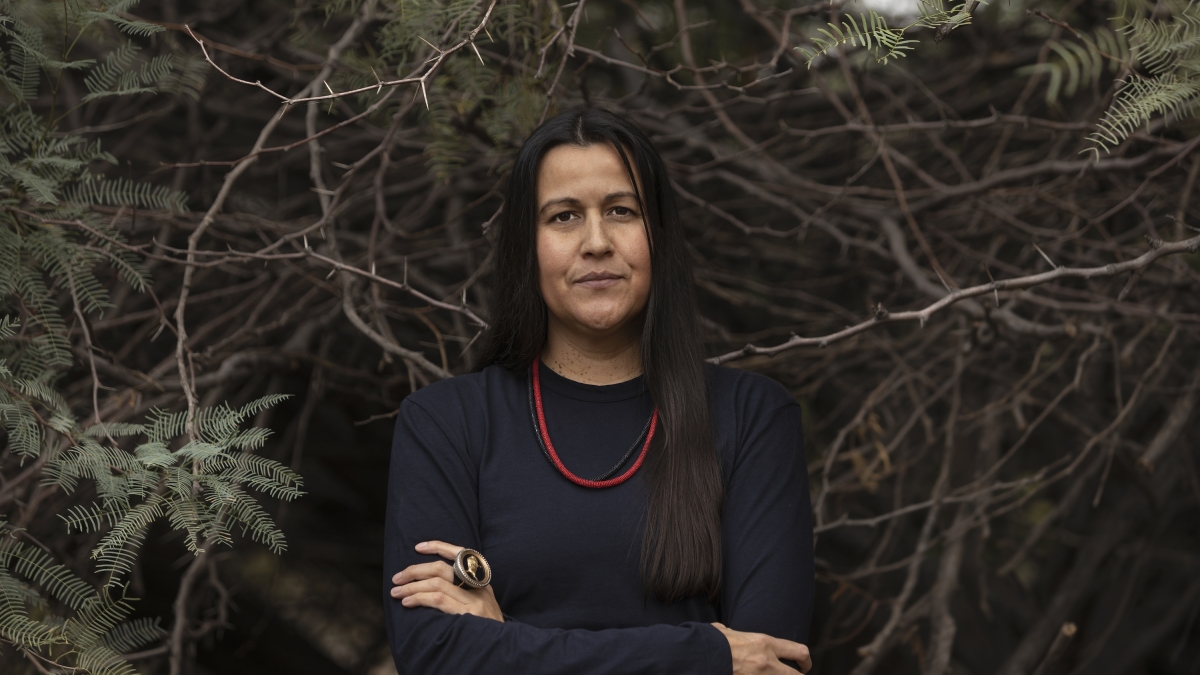Natalie Diaz loves language.
That love is evidenced by her writing, for which she was awarded the Pulitzer Prize in Poetry in 2021 for her collection “Postcolonial Love Poem.”
It’s also a part of her heritage. Diaz, an associate professor in Arizona State University’s Department of English, was born in the Fort Mojave Indian Village in Needles, California, and is an enrolled member of the Gila River Indian Community.
The love for her native Mojave language is the backdrop for Diaz’s appearance on "Habla Loud," the latest installment in the award-winning "Habla" series on HBO. "Habla Loud," which features celebrities and influential Latinos sharing their stories of being Latino in the United States, will premiere at 8 p.m. Arizona time on Friday, Oct. 7, on HBO Latino.
ASU News talked to Diaz about the show and the work she’s done to ensure the Mojave language is preserved.
Editor's note: The following interview has been edited for length and clarity.
Question: Tell me about your part in the show.
Answer: Something really generous about the series is the way it’s looking at what’s considered Latina, Latino, Latinx. Because identity is always tense. And something that’s been really important for me about his (director Alberto Ferrera's) vision and viewpoint of this is that it’s really constellating a very large community that’s also very nuanced. This often happens with Indigenous people as well, and I’m included as a Mexican, Spanish person and a Native person in the United States.
The lens that he opened up for me to talk about the language work that I do with my elders at Fort Mojave … is really important because language, especially in the Spanish-speaking community, but also in our Native communities (is being lost). ... How do you recover that? And there’s some of the really tough things to talk about, like, "Who’s fluent, who’s not, how much do you know, am I saying it right?" So, it was really lucky that he invited me, and that’s where the conversation went.
Q: Ferreras is quoted as saying you’re trying to “rescue” the Mojave language. Is that the case?
A: So, I’m from Fort Mojave, which means the military base was there. In order, it was: Spanish explorers, Mormons, the Ives expedition, the railroad. And then as the railroad came in, they built the military base, once we were kind of quieted and broken down. Then the military was able to leave because we were no longer a threat. They turned the military base into a boarding school, and that boarding school (where English was taught) became one of the final and probably most powerful parts of the process of silencing the Mojave language.
They take the language away from the young people so that when they go home, they don’t have their language to speak back to their parents. Their parents quit speaking to them in Mojave because they don’t understand.
Q: Did you have a sense growing up there that your language was being lost?
A: I only heard my elders speaking it. When I was growing up as a kid, we had our own street version (of Mojave). We would call each other names, tease each other, maybe even say things we thought were curse words, which Mojave actually doesn’t have. Otherwise, I only heard my elders speak it. My great-grandmother, who I would take care of, she and my great-aunt spoke it together, so they would close the door when our elders came to visit and have their private conversation, which we’d sometimes overhear. Or I learned command phrases, like “behave” or “go outside.”
But, yeah, it was clear to me that it wasn’t a language spoken by young people. It was a language that felt like it was a part of us, but I didn’t quite understand it.
Q: When did you decide that you wanted to rediscover your language?
A: I was out of graduate school. I’d left my reservation for the first time to play basketball at Old Dominion University. I thought I needed to be as far away from home as possible. … Then I played basketball overseas, had a career-ending knee injury, went back to graduate school and it was after graduate school that I decided to come home. I originally wanted to just gather stories and oral histories, but my tribe asked if I would engage in this language project. I didn’t speak the language, but I was able to come back and just work side by side with my elders.
I spent most of my days with them and, in particular, (an elder named) Hubert almost every day. I knew I wanted to write. I knew I had a gift of writing and that I could express myself. That was what kind of made made me decide that I can go and help tell some of the stories that I heard growing up.
Q: What did your work consist of?
A: One of the things that I did was work with my elders to find pathways for them to share the language, because that’s the same way that the boarding school took away the opportunity to teach our children a language. Our current society doesn’t give elders a lot of opportunity to share. We were doing a lot of recordings — audio and video recordings. I learned small but really important things. I would ask, “How do we say, ‘Are you hungry?’” And what they would tell me is we don’t ask if you’re hungry. We simply feed you. But here’s a way that you might express that. I think we forget sometimes that language is not just about the product that comes at the end or the action, but it’s all of the values included.
Q: How long did the work take, and what was the final result?
A: We have a pretty large archive. I was working with elders individually and recording their stories and turning them over to their families. There are still some projects that we didn’t get to (because Hubert recently passed away). However, I have the previous recordings that he did, and a lot of it is still ongoing.
I think some of it was simply revitalizing people’s interest in it. We have a culture center at Fort Mojave that is carrying on some of that work, but losing (Hubert) is a big blow. It really just shifts your mind and makes you think of all that’s lost. But also everything that he gave us by opening up to us. I was working with him almost every day for five years. I have so much of the language he gave me streaming through me and in me.
The more difficult part, of course, is in all the things we gather and collect, how do you turn those into dissemination tools? How do you create things? That was what he and I had been working on the last few years, figuring out ways that we might create materials and put them into archives and places where people can access them. We think about language work as being in the past because we’re looking back toward something lost or a time when it was spoken, but I think what I learned from him is that it’s actually very much about preparing for the future in which we might speak it again. I think that was a gift I didn’t realize until just the last few days when we lost him.
Q: Is it your hope, then, that this has a generational impact in the sense that the Mojave language lives on?
A: Yes. One of the things that he (Hubert) always talked about, and I think a lot about, is things like dreaming and play. We forget the importance of those in terms of language-making, because language becomes so utilitarian that you just expect it, you assume it. You can teach a language in class to students, but if they’re not speaking it, if they’re not teasing each other in it, if they’re not making jokes… Really, for the language to be alive, we need to create opportunities for young people to engage in those ways, to be able to text each other in it, or create new stories of their own or new songs, things like that.
I also realize that it took a long time for that silencing to happen. It’s going to take a while for it to be heard, more often, more loudly, with joy. So, I think it’s about now working with people imagining what that future can look like.
Top photo courtesy Scott Baxter photography
More Arts, humanities and education

ASU student finds connection to his family's history in dance archives
First-year graduate student Garrett Keeto was visiting the Cross-Cultural Dance Resources Collections at Arizona State University as part of a course project when he discovered something unexpected:…

ASU alumna makes her way back to the ASU Gammage stage for '¡azúcar!'
As the Los Angeles-based CONTRA-TIEMPO dance group prepares for its upcoming production “¡azúcar!” at ASU Gammage, for one member of the dance group it is also a nostalgic return to her home.Born in…

ASU FIDM professor wins international award for fantastical, sustainable creation
The horror of an ailing Earth inspired an Arizona State University fashion professor to create a fantastical garment out of sustainable, re-used and found materials that won a prestigious…
